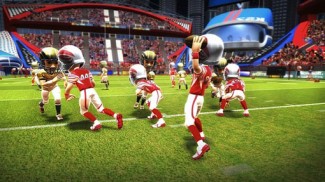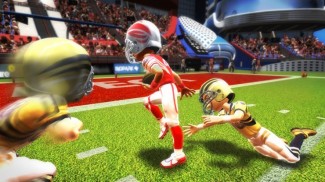Bastion
LQ: 9.15
Recommended Age: 10+
Skills Used: Planning, Working Memory, Mathematics, Reading
In Kinect Sports Season Two: Football, the player interacts with Microsoft Kinect, using motion controls to mimic playing football. First, the player picks a play, then throws the ball when a teammate becomes open. Once the teammate receives the ball, the player has to run in place in order to gain yards. Just like real football, the player will need to reach the end of the field without being tackled in order to score a touchdown. After the player scores, the defensive portion of the game is completely simulated, and the player will get to throw the ball again during the subsequent play. If the player does not score within four plays, the ball is turned over to the other team. After the four quarters of the game are completed, the final scores are tallied and the player with the most points wins. This game is recommend for kids ages 7 and up because there is no inappropriate content and the game is easy to learn and play.
Adapting and adjusting to changing conditions and expectations.
 The player needs to choose a variety of plays from the book instead of relying on just one. If the player continually repeats a particular play, the opponent will figure out his game, and likely prevent the pass. The player should think about how many downs he has left, and choose the right play accordingly. If the player has only a small distance to go, then a short play like 'slants' will be sufficient. If the player has a large distance to travel, a long play like 'steaks' would be a better idea.
The player needs to choose a variety of plays from the book instead of relying on just one. If the player continually repeats a particular play, the opponent will figure out his game, and likely prevent the pass. The player should think about how many downs he has left, and choose the right play accordingly. If the player has only a small distance to go, then a short play like 'slants' will be sufficient. If the player has a large distance to travel, a long play like 'steaks' would be a better idea.
Recalling and retaining information in our minds while working.
The player will need to remember the play depicted in the book, so that he will know precisely when to throw the ball to teammates. After studying the play, the quarterback will only have a short time after calling hike before being rushed by the opposing team, and must quickly remember where his receivers are traveling so he can throw to the right player. For example, the play 'slants' makes a receiver run and then cut to the left. The player will need remember that key aspect, which player is performing it and then throw the ball to the left when the receiver becomes open. If the player does not recall this information quickly and correctly, he may miss open receivers or mix up their preplanned routes.
Being efficient and aware of our use of time and effort. Estimating time and meeting deadlines.
 The player will need to look at the clock and decide which plays are best for the remaining amount of time on the field. If the player is behind on points, and only has a few minutes left before the game is over, he may want to go long and try to score with a more difficult play. If the player is ahead on points, he may want to use short passes and simple plays in order to run down the clock and win the game.
The player will need to look at the clock and decide which plays are best for the remaining amount of time on the field. If the player is behind on points, and only has a few minutes left before the game is over, he may want to go long and try to score with a more difficult play. If the player is ahead on points, he may want to use short passes and simple plays in order to run down the clock and win the game.
All membership plans come with full access to our entire suite of tools learning guides, and resources. Here are a few of the ones we think you’ll like the most: